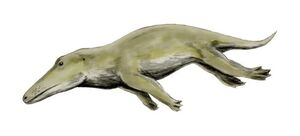(File added via photo placeholder) |
No edit summary Tag: Source edit |
||
| Line 2: | Line 2: | ||
''Ambulocetus natans'' lived in the Early [[Eocene]] (50 to 48 million years ago) of [[Pakistan]]. When the animal was alive, Pakistan was a coastal region of [[India]], which was then an island continent in the Indian Ocean (see Indian Plate). |
''Ambulocetus natans'' lived in the Early [[Eocene]] (50 to 48 million years ago) of [[Pakistan]]. When the animal was alive, Pakistan was a coastal region of [[India]], which was then an island continent in the Indian Ocean (see Indian Plate). |
||
| + | |||
==Description== |
==Description== |
||
Having the appearance of a 3 meter (10-foot) long mammalian [[crocodile]], it was clearly amphibious, as its back legs are better adapted for swimming than for walking on land, and it probably swam by undulating its back vertically, as otters and whales do. It has been speculated that Ambulocetids hunted like crocodiles, lurking in the shallows to snatch unsuspecting prey. Chemical analysis of its [[teeth]] shows that it could move between salt and fresh water. ''Ambulocetus'' did not have external ears. To detect prey on land, they may have lowered their heads to the ground and felt for vibrations.[1] |
Having the appearance of a 3 meter (10-foot) long mammalian [[crocodile]], it was clearly amphibious, as its back legs are better adapted for swimming than for walking on land, and it probably swam by undulating its back vertically, as otters and whales do. It has been speculated that Ambulocetids hunted like crocodiles, lurking in the shallows to snatch unsuspecting prey. Chemical analysis of its [[teeth]] shows that it could move between salt and fresh water. ''Ambulocetus'' did not have external ears. To detect prey on land, they may have lowered their heads to the ground and felt for vibrations.[1] |
||
Scientists consider ''Ambulocetus'' to be an early whale because it shares underwater adaptations with them: it had an adaptation in the nose that enabled it to swallow underwater, and its periotic bones had a structure like those of whales, enabling it to hear well underwater. In addition, its teeth are similar to those of early cetaceans. |
Scientists consider ''Ambulocetus'' to be an early whale because it shares underwater adaptations with them: it had an adaptation in the nose that enabled it to swallow underwater, and its periotic bones had a structure like those of whales, enabling it to hear well underwater. In addition, its teeth are similar to those of early cetaceans. |
||
| + | |||
==Discovery== |
==Discovery== |
||
''Ambulocetus natans'' was recovered from the Upper Kuldana Formation of Pakistan in 1993 by Johannes G.M. Thewissen and Sayed Taseer Hussain. It was described by Thewissen, Hussain, and Mohammad Arif in 1994.[2] It is believed to be from the Lutetian (48.6 to 40.4 million years ago). |
''Ambulocetus natans'' was recovered from the Upper Kuldana Formation of Pakistan in 1993 by Johannes G.M. Thewissen and Sayed Taseer Hussain. It was described by Thewissen, Hussain, and Mohammad Arif in 1994.[2] It is believed to be from the Lutetian (48.6 to 40.4 million years ago). |
||
| + | |||
==Taxonomy== |
==Taxonomy== |
||
| + | |||
[[Category:Transitional fossil]] |
[[Category:Transitional fossil]] |
||
| − | [[Category:Eocene |
+ | [[Category:Eocene cetaceans]] |
[[Category:Cetaceans]] |
[[Category:Cetaceans]] |
||
[[Category:Prehistoric mammals of Asia]] |
[[Category:Prehistoric mammals of Asia]] |
||
Revision as of 22:08, 23 November 2021

Ambulocetus natans was an early cetacean that could walk as well as swim. It is the only species classified under the genus Ambulocetus. Along with other members of Ambulocetidae, it is a transitional fossil that shows how whales evolved from land-living mammals.
Ambulocetus natans lived in the Early Eocene (50 to 48 million years ago) of Pakistan. When the animal was alive, Pakistan was a coastal region of India, which was then an island continent in the Indian Ocean (see Indian Plate).
Description
Having the appearance of a 3 meter (10-foot) long mammalian crocodile, it was clearly amphibious, as its back legs are better adapted for swimming than for walking on land, and it probably swam by undulating its back vertically, as otters and whales do. It has been speculated that Ambulocetids hunted like crocodiles, lurking in the shallows to snatch unsuspecting prey. Chemical analysis of its teeth shows that it could move between salt and fresh water. Ambulocetus did not have external ears. To detect prey on land, they may have lowered their heads to the ground and felt for vibrations.[1]
Scientists consider Ambulocetus to be an early whale because it shares underwater adaptations with them: it had an adaptation in the nose that enabled it to swallow underwater, and its periotic bones had a structure like those of whales, enabling it to hear well underwater. In addition, its teeth are similar to those of early cetaceans.
Discovery
Ambulocetus natans was recovered from the Upper Kuldana Formation of Pakistan in 1993 by Johannes G.M. Thewissen and Sayed Taseer Hussain. It was described by Thewissen, Hussain, and Mohammad Arif in 1994.[2] It is believed to be from the Lutetian (48.6 to 40.4 million years ago).